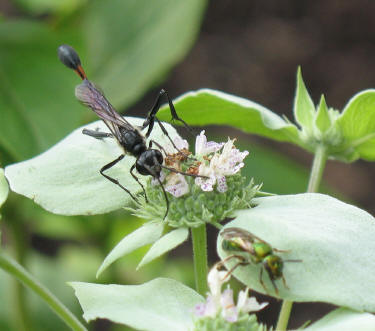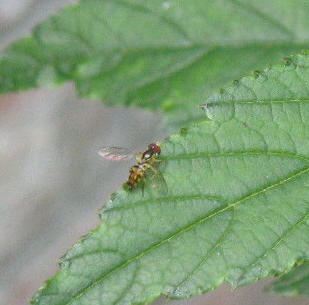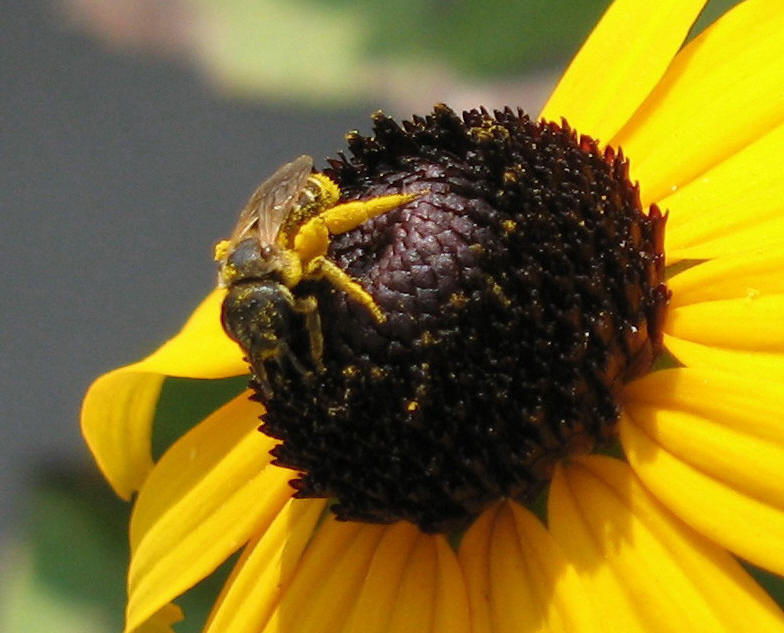Julia Cubit
Frederick County Master Gardener
Introduction
The demise of the population of the honeybee is awakening an interest in and an appreciation of other pollinators that are native to this continent. Most gardeners are familiar with a few of the plant pollinators such as butterflies, hummingbirds and bumblebees. Yet there are thousands of other
largely unrecognized creatures that pollinate. Among the insects are included many types of flies, beetles, wasps, and native bees.
If you spend much time outdoors, you are probably familiar with bumblebees, carpenter bees and sweat bees. Yet there are about 4,000 species of bees native to North America, and more than 400 of these are found in Maryland. They vary in size from a couple of centimeters to around an inch. The
smallest of these bees are rarely noticed since they frequently forage for pollen and nectar on the many smaller flowering plants found growing just about everywhere - including in many lawns.
Community Bees and Lone Nesters
 Among the native bees found in this area, only a few aggressively sting and these are the bees that form social communities such as the bumblebees. The rest are non-aggressive loners who
reproduce in nests they construct in holes found in the ground, and in holes found in trees and in other structures. Among those that do have the capability to sting when threatened, frequently it is the female of the species who has that ability - many male native bees have no stinger.
Among the native bees found in this area, only a few aggressively sting and these are the bees that form social communities such as the bumblebees. The rest are non-aggressive loners who
reproduce in nests they construct in holes found in the ground, and in holes found in trees and in other structures. Among those that do have the capability to sting when threatened, frequently it is the female of the species who has that ability - many male native bees have no stinger.
Generalists and Specialists
Most pollinators can be divided into two categories by flower preference - generalists and specialists. Pollinators that are generalists, such as the bumblebee, will visit any flower in search of pollen and nectar; while specialists have a preference for a specific type of flower. The orchard mason
bee (a shiny, dark blue bee slightly smaller than the honeybee), which pollinates flowers of fruit trees, is an example of a specialist.
Supporting a Healthy Population of Native Bees
|

Sweet Bee
|
Since many native bees nest in abandoned holes in the ground or in trees, making these habitats available will help to encourage an increase in bee populations. Sparsely vegetated patches under trees and along the sides of walkways, roads and fences will attract ground nesters.
Frequently old logs and tree stumps contain abandoned insect holes which will attract bees that nest above the ground.
Another way to provide nesting sites for wood nesting bees is to hang a nesting board. These can be as simple to make as drilling ¼" to ½ " holes about 3" deep into an untreated piece of wood such as a section of a "4 x 4". The type of bee this nesting board attracts is determined by the diameter of
the hole. For example, the orchard mason bees will use a board with ½" holes. Secure the board to the south side of a tree or building where it will get sun. One bee enthusiast drilled holes in the porch columns of his home. This is not recommended if other occupants of your abode do not share your ardor for native bees.
Other ways to support native bee populations can be as simple as allowing a variety of plants to grow. Patches of lawns that host a few small flowering plants such as sorrel and other innocuous wild plants can support a number of the smaller bees.
 Avoid using pesticides. Learn about the interactions among insects, and between insects and animals. There are many insects that are beneficial to have in the garden. Wasps, ladybird beetles, assassin bugs, ground beetles, and centipedes are predators that help keep populations of destructive
insects in check. Spraying will destroy this natural balance.
Avoid using pesticides. Learn about the interactions among insects, and between insects and animals. There are many insects that are beneficial to have in the garden. Wasps, ladybird beetles, assassin bugs, ground beetles, and centipedes are predators that help keep populations of destructive
insects in check. Spraying will destroy this natural balance.
Consider choosing native perennials when selecting new plants. Native insects have evolved alongside native plants and birds. Native plants will attract native insect pollinators such as bees and butterflies that are rarely seen in many gardens. In turn, these insects will attract songbirds which
will help to maintain overall insect populations at a healthy level.
Conclusion
Whatever is written in the final chapter on the honeybee in North America - whether the species survives the present threats to its population, or falls victim - one positive outcome will be that more people will have been made aware of the fragility and complexity of the cycle that produces food
for the world. Each of us can have an impact on this cycle by how we manage our environment. From flower to food, the cycle depends on the many pollinators - bees, flies, butterflies, beetles, bats, and birds. The survival of these creatures, to a large degree, depends on how well we are aware of their relationship to the
environment, and how we work to encourage and support their presence.
Websites
An excellent source of information about native pollinators can be found at www.pollinator.org. Detailed guides are available for regions throughout North America. Maryland is included in the brochure covering the Eastern Broadleaf Forest, Oceanic Province. This brochure also provides a list of
native plants for each region.
Read other articles on birds, bees & beneficial insects